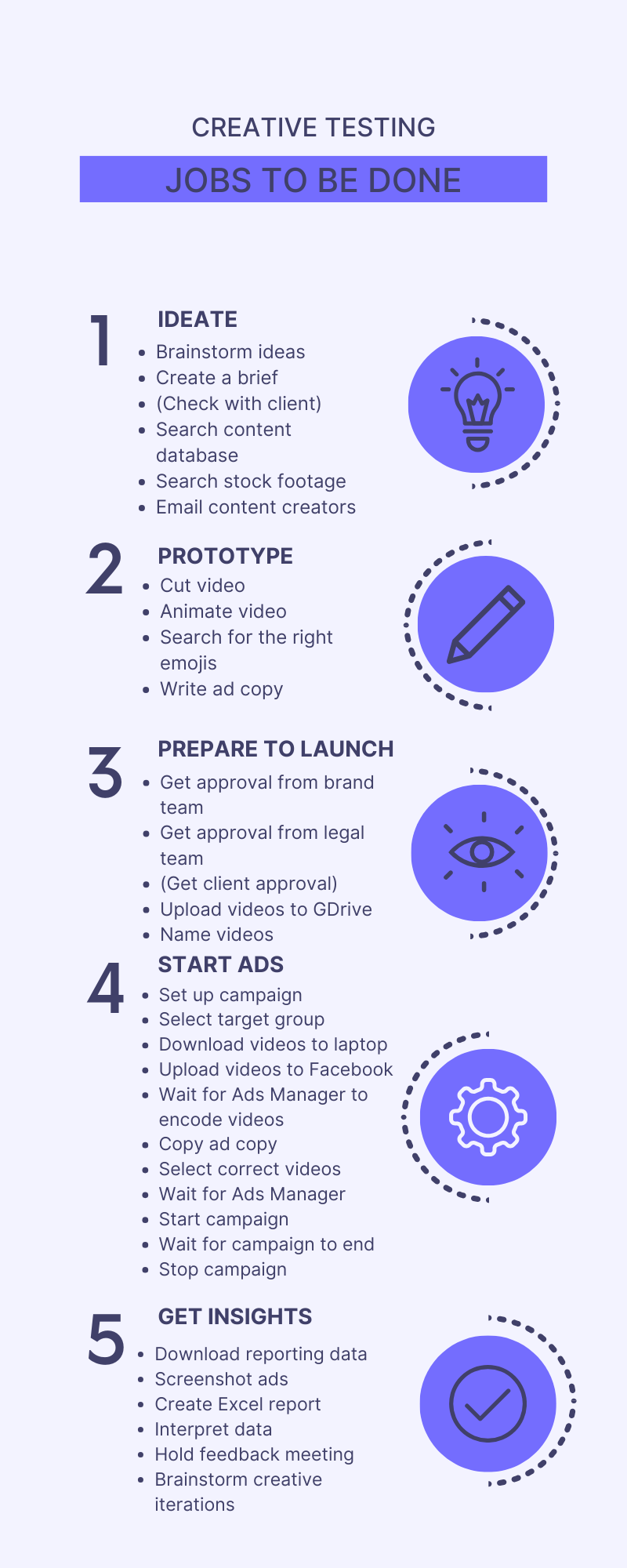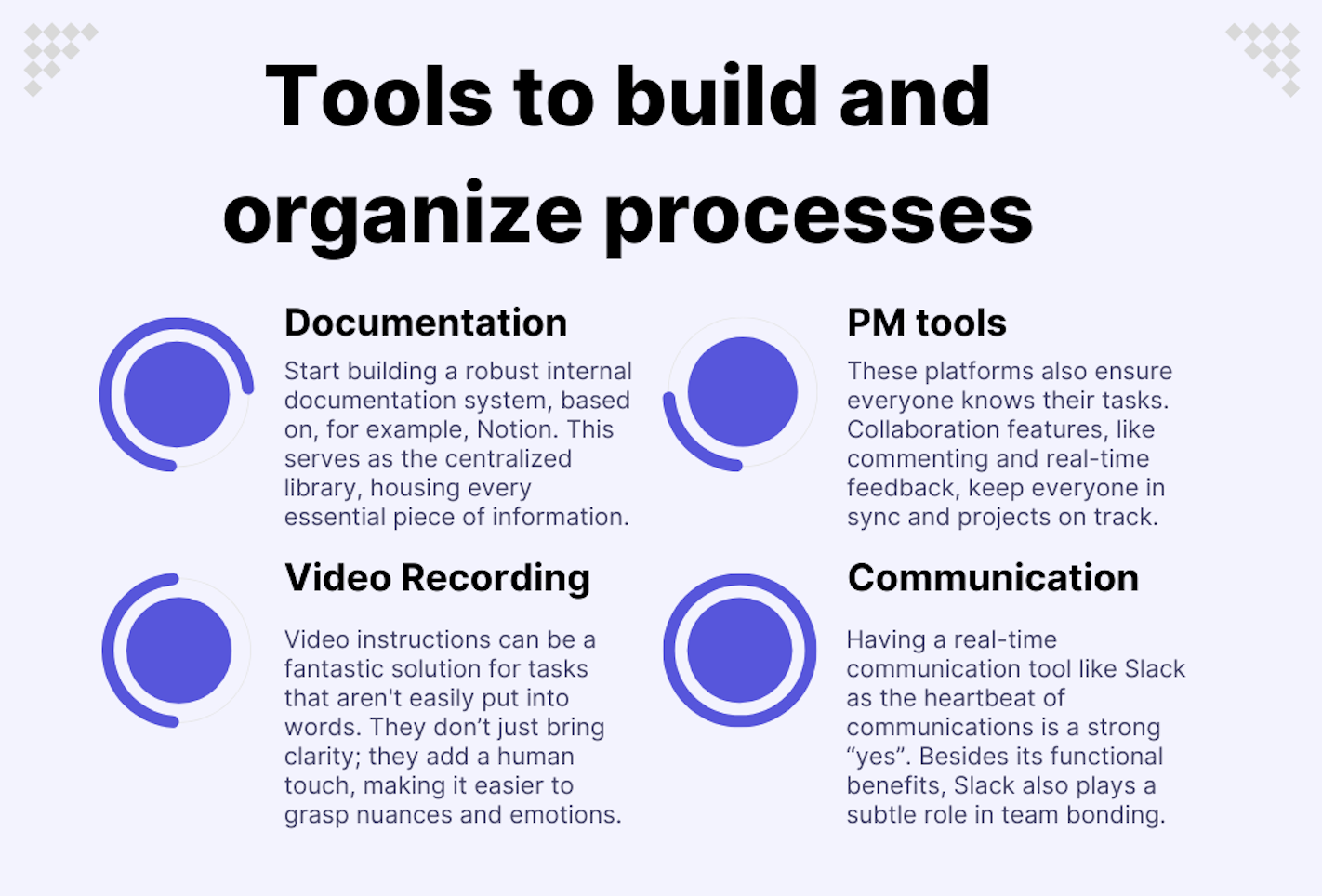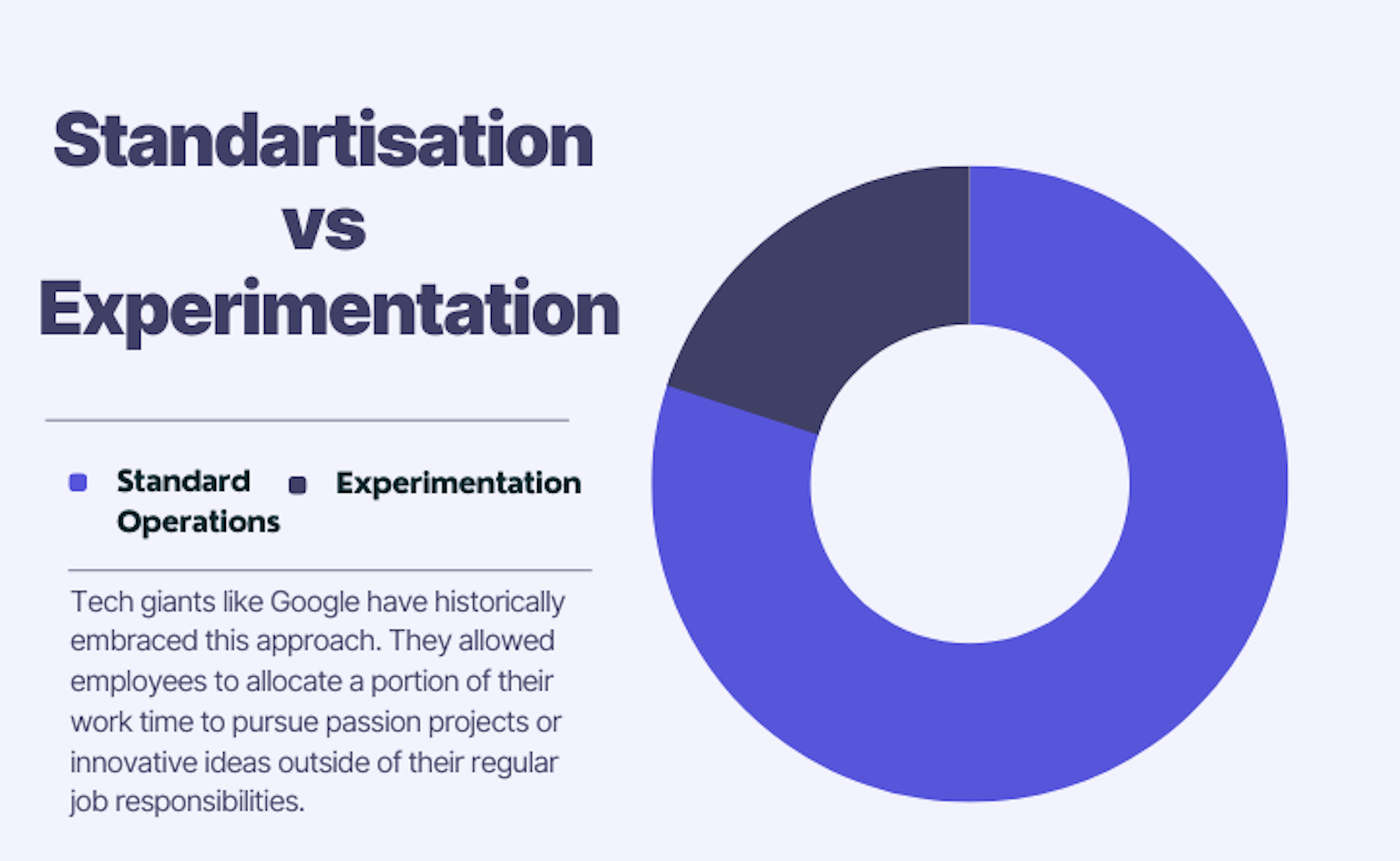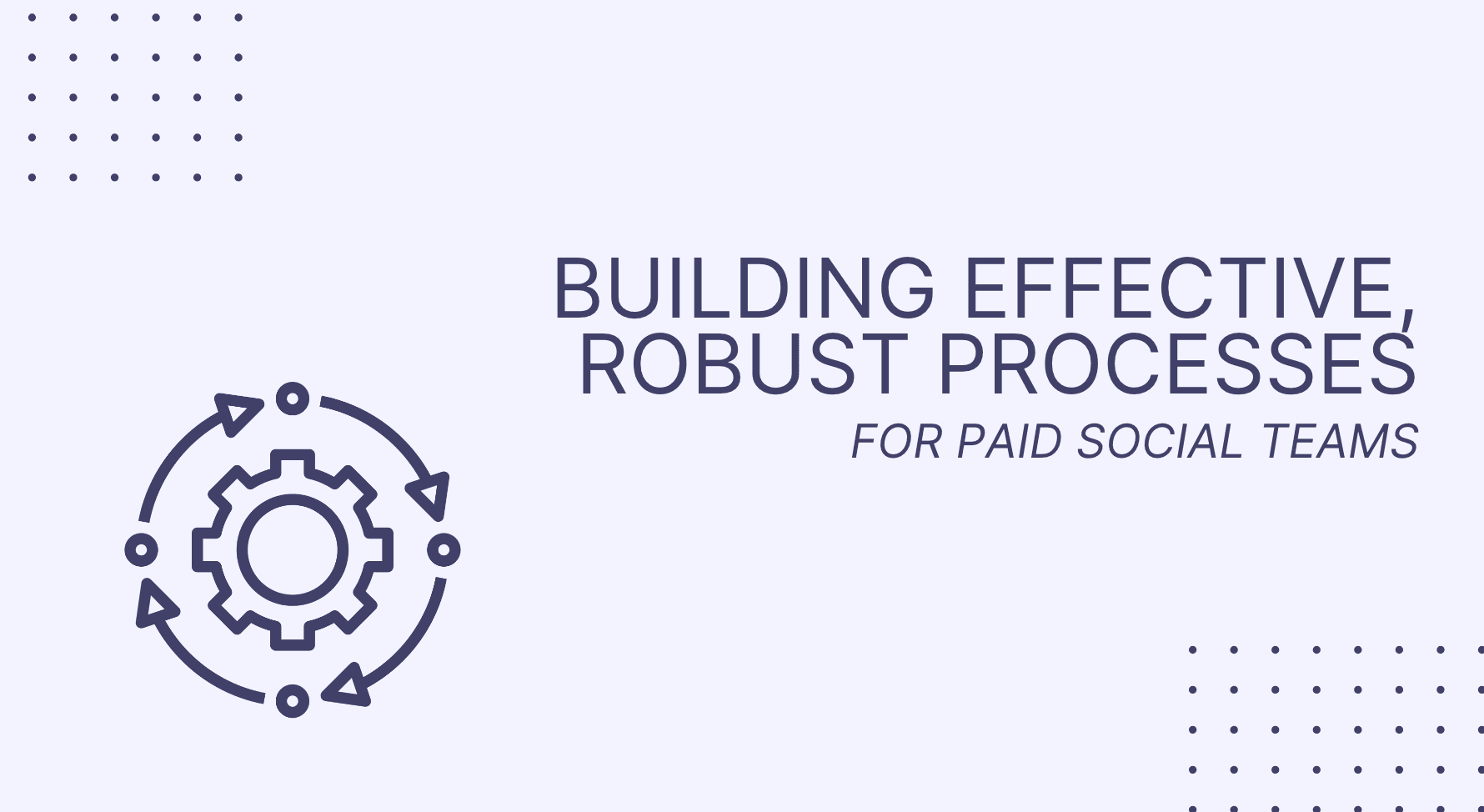Paid Social Blueprints
Building effective, robust processes for paid social teams
How do you structure your paid social team? This post offers insights into building robust and efficient paid social processes, ensuring your team is always one step ahead.
Intro
If you are a head of paid social team or a founder of an agency, you have probably defined a couple of processes and handed over the operations to other team members. In order to know whether your current processes are working well or need some adjustments you need to evaluate the replicability of it.
In this blog post we dive into the most common concepts to structure processes well, make them replicable, which lays the foundation for delegating, outsourcing and automation.
Before you start building new processes, how do you evaluate your current ones?
If you've implemented and documented a process, can someone else replicate it at least 90% as efficiently as you? For instance, if you've onboarded someone new and they've taken over client interactions in an agency setup, do they perform nearly as well as you? Are their strategies and tactics similar to yours?
How do you successfully scale your operations? The key is replicability. If one person's approach can be easily adopted by another team member, then it's likely that there's a well-defined process and possibly documentation or training in place. Without these, your team members may resort to their own methods or even search online when unsure.
Another essential aspect to consider is not just the tasks being executed, but how they're being approached by individual team members. Picture a scenario: you observe different team members, all responsible for similar duties, yet each using distinct tools and methods. This discrepancy can lead to inconsistencies in the work's output and quality.
Such variances are a clear signal that it's time to revisit, realign, and possibly standardize your processes. Standardizing doesn't necessarily mean stifling creativity or individual preferences. Instead, it's about ensuring consistency, enhancing collaboration, and optimizing the overall workflow. By ensuring everyone is aligned in their approach, the team can produce more consistent results and operate more efficiently.
Imagine leading a new paid social team with a substantial budget, having achieved impressive results and now expanding the team. The primary goal is to ensure the team is well equipped with robust and replicable processes. So, where to begin?
Let's take a look at the Jobs To be Done and SOP frameworks.
"Jobs to be Done" framework
The essence of Jobs To Be Done framework is to focus on all tasks that happens before reaching the outcome or the end goal of an activity.
For instance, if we imagine that we need to put a painting to the wall, what steps need to be done in order to achieve that? Some would argue that first thing, we need to take a hammer, a nail and then to hammer it into the wall. But are there are other ways to achieve the same result?
The question then becomes: what job does the customer really want to get done? Is it really hammering a nail into the wall or more like displaying a new painting? Instead of merely focusing on the act of hammering, they might be searching for the best method to display their artwork.
Relating this to, say, creative testing, the ultimate "job to be done" might be to consistently produce high-performing ads. The metrics for "high-performing" could vary - ROAS, CVR, CPI, and so forth. What's clear is that the emphasis should be on both "well-performing" and "reliably."
Using this framework ensures you're tackling the right challenges. For example, if you find that video quality has a larger impact on ad performance than text, it'd make sense to focus your efforts on video variations.
In essence, the Jobs to be Done approach prompts you to look at desired outcomes and adjust actions accordingly, ensuring you're aligned with the true end goal.

SOP
For a holistic view, Jobs to be Done is highly beneficial. Though, when diving into detailed execution, Standard Operating Procedures (SOPs) might be handy.
Originating from machinery operations, SOPs in the digital realm may not be as strict, but they emphasize reliability. By providing comprehensive guidelines and context, they ensure consistency, especially useful for newcomers or junior team members. An effective SOP eliminates ambiguity and enhances output predictability.
How do you start building robust processes for paid social teams, especially for those new to the concept?
There are generally two approaches: top-down and bottom-up.
Top-Down Approach
Begin with those who have hands-on experience. Have them document their tasks, perhaps using a "jobs to be done" framework. For instance, during the creative testing process, there are primary steps like creating new ad creatives. This involves brainstorming ideas, working with designers, providing feedback, etc.
Once the creatives are developed, they need to be incorporated into a campaign with the appropriate ad copy, landing pages, and targeting. After launch, monitor the campaign's performance, make necessary adjustments, and report the results. This approach involves mapping out tasks based on expertise and theory.
Bottom-Up Approach
Here, instead of theorizing, you analyze what tasks are being done in reality. Break down the workweek into time slots and record actual activities. This provides a realistic snapshot of current processes, revealing possible inefficiencies. For example, if ads are consistently launched later than planned because of design delays, it's an area for improvement.
The ultimate goal, regardless of approach, is to identify time spent on each task, inefficiencies, and areas for optimization. Ensuring processes align with real-world operations and address actual challenges leads to a more effective and efficient system.
How do you assess the specific needs of a paid social team and tailor the tools and processes accordingly?

Documentation tools (text)
In a world where paid social teams juggle quite a bit of different tasks, having the right tools in our arsenal isn't just a luxury – it's essential. One of the foundations of successful operations is a robust internal documentation system, based on, for example, Notion. This serves as the centralized library, housing every essential piece of information.
It's not just about storage: this system reduces inconsistencies by giving everyone the same source of truth. Newcomers to the team would also find it very valuable, as it streamlines their onboarding process, granting them access to standard operating procedures and other critical documents.
Documentation tools (videos)
Now, while written documentation is valuable, sometimes, we just need to see things in action. That's where tools like Loom come into play, letting us illustrate processes for better understanding.
These video instructions can be a fantastic solution for tasks that aren't easily put into words. They don’t just bring clarity; they add a human touch, making it easier to grasp nuances and emotions. And let's be honest, not everyone is a fan of reading. Visual guides can resonate better with many team members, especially those who lean towards visual learning.
Project Management tools
But what about keeping track of tasks, deadlines, and responsibilities? That’s where project management tools, such as Asana or Monday, enter the game. They don't just list tasks; they give us a panoramic view of every project in motion.
It's a game-changer for managers, helping them distribute resources where they're needed most. These platforms also ensure everyone knows their roles, ensuring accountability. The built-in collaboration features, like commenting and real-time feedback, keep everyone in sync and projects on track.
Communication tools
Lastly, while not mandatory, having a real-time communication tool like Slack can be a tremendous asset. It's the heartbeat of communications, perfect for those "drop everything" moments.
Besides its functional benefits, Slack also plays a subtle role in team bonding. Those casual chat channels? They're the digital equivalent of water cooler conversations, allowing for both work discussions and the occasional light-hearted banter. Plus, with the ability to integrate other tools, it makes pulling up tasks or documents during conversations incredibly seamless.
In essence, for a team to function at its best, it's not just about the people but also about equipping them with the right tools.
However, it's essential to mention that while communication tools offer numerous benefits, they can sometimes become a distraction. Hence, if a team is well-aligned with its project management and knowledge base tools, and if the processes are thoroughly documented, there might be limited need for real-time chat tools. The focus can be on asynchronous communication, via Loom, for example, allowing team members to deep dive into tasks without frequent interruptions.
How do you find the balance between agility and standardization?
Of course, having a balance between the agilile approach and standardization is crucial for any organization aiming for sustainable growth and innovation. To paint a clearer picture, consider the following scenarios.
First, look at sales within emerging startups and agencies. In these environments, sales techniques are incredibly dynamic. Whether it's the founders or salespeople, there's often a real-time adaptation of product pitches based on feedback during a call.
It's a fantastic way to ensure the product or service is always improving. But there's a flip side: sometimes, in the enthusiasm of a pitch, a salesperson might sell a not yet existing feature without fully grasping its development timeline. This can create mismatched expectations for clients and hard times on product teams.
What would be the optimal way? Stick to the established product details during pitches, but always collect and review client feedback to shape future offerings.
Then there are roles bursting with creativity, like video editing or graphic design. Creative professionals are constantly exposed to novel techniques they believe could enhance their work.
However, decisions made in isolation might get too away from a project's intent or a client's wish, leading to additional revisions. It's essential, then, for these professionals to share their innovative suggestions, get feedback, and ensure that their creativity aligns with the project's core objectives.
The 80-20 Rule for Standard Practices vs. Experimentation
A structured approach to balance standardization and agility is to allocate a specific portion of time or resources for experimentation. The "80-20" rule is a great example for that. It suggests that teams should spend 80% of their time on well-established practices and dedicate the remaining 20% to innovative experiments or new ideas.
Tech giants like Google have historically embraced this approach. They allowed employees to allocate a portion of their work time to pursue passion projects or innovative ideas outside of their regular job responsibilities. Sometimes, they would allocate the whole day to it! Such practices not only foster creativity but also can lead to groundbreaking innovations.
While agility is crucial in adapting to the ever-evolving market dynamics, standardization ensures consistency, quality, and reliability. The key is to harmoniously integrate both, ensuring that one doesn't overshadow the other.

How do you ensure that all your processes are up to date and align with your organization's objectives in real-time?
Ensuring that our processes align with the organization's goals in real-time is a bit like steering a ship with a compass.
Objective Clarity
Firstly, everything is based on the crew knowing where we're headed. Just as a ship's captain needs to know the destination, every process we set up starts with a crystal clear idea of what we're trying to achieve. When everyone knows the destination, it becomes easier to decide on routes, tactics, and strategies.
Understanding Limitations
Then there are challenges and constraints we have to factor in. For example, imagine working in a creative agency where you can't just roll out an ad because you think it's good. It needs approval from the brand first. That's a bit like knowing there's an island or shallow waters in your path, and you need to navigate around them.
Encouraging Innovation Within Boundaries
Now, even with these guidelines, there's still room to try out new things and get creative. Let's say you're the ship's navigator. You know the destination and the obstacles, but you can choose different methods or tools to plot the course. Similarly, a designer might want to try out a new tool to create ads, but they need to ensure they stay on track and deliver on time.
Process Owner
Lastly, every ship needs a captain, and in processes it's the Process Owner. This person ensures that, amidst all the exploration and innovation, we're still aligned with our goals and moving in the right direction. They stay updated with the latest trends, like a captain keeping an ear to the ground for weather updates, ensuring the journey is smooth and ahead of the curve.
While we always aim for innovation and staying updated, it's the balance of clarity, understanding our constraints, creativity, and strong leadership that keeps us on the right path.
How do you assess the effectiveness of the processes you've established?
To truly understand the effectiveness of a process, you need to delve deeper than just surface observations.
Establishing clear metrics
Define what success looks like. First, you've got to know what you're aiming for. Imagine you're evaluating the success of an ad campaign. You'd need to decide upfront what makes an ad successful. Is it the return on investment? The number of views? Or maybe the amount of engagement it generates? Having a solid benchmark, like aiming to roll out ten standout ads over three months, gives you a goal to strive for.
Efficiency Measurement
Once you have a clear target, the next step is to understand the resources required to hit that target.
Think of a creative hit rate - it's a bit like knowing you want to make the perfect video ad and figuring out how many attempts it'll take to get there. It could mean determining how many ads you'd have to test before you get those ten golden ones.
But, of course, resources can't be ignored. No process evaluation is complete without considering the budget. How much are you willing to invest to achieve your targets?
This could mean deciding between hiring seasoned pros or fresh talent, both of which have their pros and cons and can affect your overall budget and the quality of output.
The beauty of this entire process? It's all about learning on the go. Even if something unexpected throws a spanner in the works, like a sudden shift in team dynamics or market trends, you can recalibrate and tweak as you go along. The ultimate goal is always refining the process for better results.
Next Read
Paid Social Blueprints
Is it worth starting to invest in paid social automation? Calculating the ROI
Expert Opinions
AI Revolution in Paid Social Marketing: Strategies, Trends, and Insights with Mike Taylor
Paid Social Blueprints


